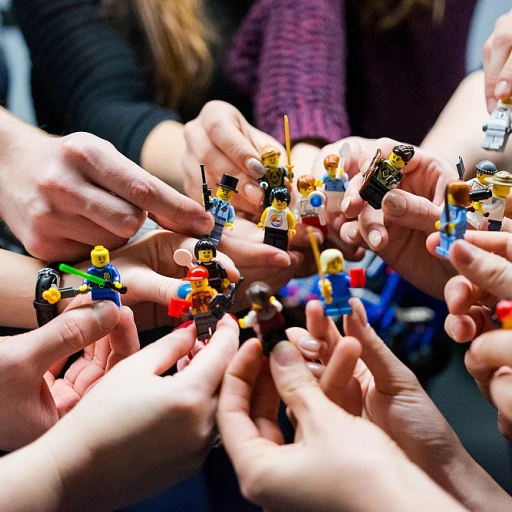
Understanding the Role of a Graphic Design Intern
The Role of a Graphic Design Intern
Embarking on a career in graphic design as an intern is a crucial step for many aspiring designers. The role of a graphic design intern is designed to provide hands-on experience and insight into the workings of a professional design team. These internships are typically offered by companies in the creative sectors, including marketing firms, design studios, and product development companies.
As an intern, you won't just view the processes—you'll actively participate in them. This includes contributing to design projects, assisting with social media graphics, and supporting the development of marketing materials. Many interns also gain experience working with essential tools and software that are fundamental to the job, such as Adobe Creative Suite or Sketch.
What makes this role particularly enticing is the variety of learning opportunities available. You'll see firsthand how theoretical knowledge applies in real-world scenarios while adapting to the fast-paced environment of design jobs. Moreover, graphic design interns are often encouraged to bring fresh perspectives to projects, fostering creativity and innovation.
It's important to remember that internships in this field can lead to a range of career paths, from product designer roles to senior design positions. These entry-level intern jobs often serve as a platform for networking, learning, and growth, enabling you to leverage your experience for long-term career success. By developing a comprehensive view of the industry, embracing challenges, and effectively using your time in this role, you can pave the way for future opportunities in graphic design.
Essential Skills for Aspiring Graphic Design Interns
Key Skills Every Aspiring Graphic Design Intern Should Cultivate
Diving into a graphic design internship requires a diverse set of skills, intersecting creativity with technical know-how. As a burgeoning designer, assiduously developing these foundational abilities can significantly bolster your internship experience and set the stage for your career trajectory.
- Mastering Design Software: Proficiency in industry-standard software such as Adobe Creative Suite is a non-negotiable requirement. Tools like Photoshop, Illustrator, and InDesign are essential, allowing you to bring your creative concepts to life effectively.
- Understanding User Experience: Integrating the principles of user experience (UX) into your design process can augment your approach, ensuring the final product is both visually compelling and user-centric.
- Harnessing Social Media Trends: Awareness of prevailing trends and leveraging them in your design can give your work a cutting-edge feel. Understanding how different platforms like Instagram and Pinterest interact with graphic design can be invaluable.
- Effective Communication: As a design intern, translating ideas into visual designs often requires clear communication. Being articulate helps in conveying your creative vision to the design team and understanding client needs.
- Organizational Skills: Managing projects while adhering to tight deadlines highlights your ability to juggle multiple responsibilities, a very attractive trait for a company seeking efficient team players.
Acquiring these skills is an ongoing process, and internships offer the ideal environment for practical application. Additionally, exploring career opportunities in other related fields can provide fresh insights into cross-industry design applications.
Building a Portfolio: Your Gateway to Opportunities
Crafting an Impactful Visual Statement: The Art of Portfolios
For those diving into the competitive landscape of graphic design, creating a robust portfolio is your ticket to standing out from the crowd. A well-curated collection of your work serves not only to showcase your skills but also to articulate your unique design perspective.
To kickstart your journey as a design intern or land those coveted intern jobs, consider embedding elements of product design and user experience in your portfolio. Having a range of samples that include different styles and projects done with various tools from social media icons to product marketing material can demonstrate versatility.
- Diversification: Display a mix of projects, from complex graphic design jobs to simpler works. This provides potential employers a broad view of your capabilities, whether it is in handling user agreement interfaces or visual representations for cookies policies.
- Storytelling: Each piece in your collection should tell a story. Explain your design process, the challenges you overcame, and how the final product met the client’s needs or answered the company's creativity goals.
- Online Presence: Don’t limit your portfolio to physical copies. Having an updated digital presence, such as a LinkedIn portfolio or a personal website, makes it easier for potential employers to view job history and stakeholders in places like York City to access your work.
Keep in mind, the design industry's appetite for driven designers knows no bounds, with roles ranging from software engineer collaborations to senior design responsibilities. With careful planning and an eye for detail, your portfolio can truly be your gateway to opportunities in the competitive market of internships and intern jobs.
Moreover, understanding policies such as privacy policies and cookies is advantageous as it adds another layer to your versatility when applying for roles in prominent companies. Starting this journey with internships not only builds your skillset but also frames a foundation for long-term career growth.
Providing evidence of your growth through a methodically constructed portfolio aligns with a firm's needs and reflects a readiness to adapt to the dynamic requirements of design teams. This strategic approach speaks volumes about your readiness for more substantial challenges in the future.Learn more about creating a portfolio that resonates with potential employers.
Networking Strategies for Aspiring Graphic Designers
How to Expand Your Professional Network
Breaking into the graphic design field, especially through internships, requires more than just having the right skills and a stunning portfolio. Networking can significantly boost your chances of landing that design intern position. Here's how you can effectively expand your professional network:
- Leverage LinkedIn: This platform is a goldmine for connecting with companies and industry professionals. Ensure your LinkedIn profile accurately reflects your experience and aspirations as a graphic designer. Engage with content related to design, join relevant groups, and follow companies you are interested in.
- Attend Design Events: Participate in workshops, webinars, and conventions in York City or even virtually. These events provide opportunities to meet like-minded individuals and even potential employers.
- Engage on Social Media: Platforms like Instagram and Twitter are great for graphic designers to showcase their work. More importantly, they are places to connect with other designers. Use hashtags related to design internships, products, and jobs to gain visibility.
- Network with Your Design Team: If you're currently involved in any projects, make the most of the contacts you have. Reach out to your design team or colleagues for advice on upcoming intern positions or job openings.
Networking effectively requires patience and authenticity. Always tailor your interactions to provide value, whether you’re discussing a new design product or sharing insights into your graphic design journey. This approach promises not only immediate results in securing an intern role but also long-term growth in your career, as outlined in previous aspects of your graphic design transition. Remember, every conversation could be a step closer to your dream design internship.
Overcoming Challenges in the Transition to Graphic Design
Facing and Overcoming Common Obstacles
Navigating your way into the world of graphic design can be as challenging as it is rewarding. Aspiring interns often face obstacles that range from intense competition to adapting to a dynamic industry. Let’s explore some of the common hurdles and how you can overcome them:- Underestimating the Learning Curve: The transition to a graphic design internship demands a consistent focus on learning and adaptation. With technology and design trends evolving rapidly, staying up-to-date is crucial. Embrace continuous learning through online courses and educational sites.
- Overwhelming Competition: With top companies in places like York City seeking the best talent, standing out is key. Leverage unique aspects of your portfolio, as discussed earlier, to highlight your creative vision and technical skills.
- Lack of Experience: Employers often look for experience, even in intern jobs. To counter this, emphasize your versatility by detailing how your past ventures in related fields, such as marketing or product design, contribute to your graphic design prowess.
- Networking Barriers: Building a professional network can be daunting. Utilize platforms like LinkedIn to connect with industry professionals and join graphic design communities where you can learn about internship opportunities and company culture.
- Adjustment to Professional Environments: Transitioning from a casual environment to a professional setup requires resilience. Prioritize effective communication and time management, ensuring you can work harmoniously within a design team setting.
Leveraging Internships for Long-Term Career Growth
Maximizing the Internship Journey
Internships can be the golden ticket to landing that dream job in graphic design. Viewing them not just as brief stints but as opportunities for learning and networking is crucial. Here’s how you can leverage these experiences for long-term career growth:- Embrace Learning Opportunities: Internships offer firsthand experience in the graphic design industry. From understanding a company's design policy to collaborating with a design team, every task adds to your skill set.
- Create Connections: As discussed, networking is key. The relationships you build during your internship can open doors to future design jobs. Use professional platforms like LinkedIn to stay connected.
- Showcase Skills and Projects: Ensure the work you do as an intern is reflected in your portfolio. Experience gained in software engineering or product design tasks, even in supporting roles, highlights your versatility.
- Seek Feedback: Regular feedback from senior designers can guide you in fine-tuning your abilities. Engaging in constructive discussions about user experience and product design can elevate your skills.
- Understand Career Paths: Internships often give insights into various design paths, such as becoming a product designer or a specialist in marketing graphics. This knowledge helps in carving your future career.
- Stay Updated with Trends: The field of graphic design is always evolving. Staying informed about industry trends and updates, even those emerging in bustling hubs like York City, is critical.












